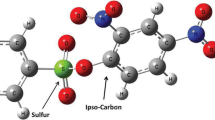Abstract
We present a critical discussion related to the recent definition of the intrinsic reactivity index, IRI, (Tetrahedron Lett. 2013, 54, 339-342; Tetrahedron 2013, 69, 4247-4258) formulated to describe both, electrophilicity (charge acceptance) and nucleophilicity (charge donation) reactivities. We here stress that such an IRI model, based on the quantity μ/η, should be properly related to theoretical approximations associated to the change in the global electronic energy of a given chemical system under interaction with a suitable electron bath (Gazquez JL et al. J Phys Chem A 2007, 111, 1966-1970). Further, the limitations of the IRI model are presented by emphasizing that the intrinsic relative scales of electrophilicity and nucleophilicity within a second-order perturbation approach must account for the further stabilization of the two interacting species (Chamorro E et al. J Phys Chem A 2013, 117, 2636-2643).

Relative electrophilicity/nucleophilicity reactive responses
Similar content being viewed by others
References
S-i K, Kaneno D, Fujiyama R (2013) Intrinsic reactivity index as a single scale directed toward both electrophilicity and nucleophilicity using frontier molecular orbitals. Tetrahedron 69:4247–4258. doi:10.1016/j.tet.2013.03.083
S-i K, Kaneno D, Fujiyama R (2013) Parr's index to describe both electrophilicity and nucleophilicity. Tetrahedron Lett 54:339–342. doi:10.1016/j.tetlet.2012.11.039
Geerlings P, De Proft F, Langenaeker W (2003) Conceptual density functional theory. Chem Rev 103:1793–1873. doi:10.1021/cr990029p
Ayers PW, Anderson JSM, Bartolotti LJ (2005) Perturbative perspectives on the chemical reaction prediction problem. Int J Quantum Chem 101:520–534. doi:10.1002/qua.20307
Ayers PW, Parr RG (2000) Variational principles for describing chemical reactions: The Fukui function and chemical hardness revisited. J Am Chem Soc 122:2010–2018. doi:10.1021/ja9924039
Chermette H (1999) Chemical reactivity indexes in density functional theory. J Comp Chem 20:129–154. doi:10.1002/(sici)1096-987x(19990115)20:1<129::aid-jcc13>3.0.co;2-a
Parr RG, Von Szentpaly L, Liu (1999) Electrophilicity index. J Am Chem Soc 121:1922–1924. doi:10.1021/ja983494x
Chattaraj PK, Sarkar U, Roy DR (2006) Electrophilicity index. Chem Rev 106:2065–2091. doi:10.1021/cr040109f
Chattaraj PK, Roy DR (2007) Update 1 of: Electrophilicity Index. Chem Rev 107:PR46–PR74. doi:10.1021/cr078014b
Chattaraj PK, Giri S, Duley S (2011) Update 2 of: Electrophilicity Index. Chem Rev 111:PR43–PR75. doi:10.1021/cr100149p
Parr RG, Yang W (1989) Book density functional theory of atoms and molecules. Oxford University Press, Oxford
Gazquez JL, Cedillo A, Vela A (2007) Electrodonating and electroaccepting powers. J Phys Chem A 111:1966–1970. doi:10.1021/jp065459f
Chamorro E, Duque-Norena M, Perez P (2009) Further relationships between theoretical and experimental models of electrophilicity and nucleophilicity. J Mol Struct (THEOCHEM) 901:145–152. doi:10.1016/j.theochem.2009.01.014
Chamorro E, Duque-Norena M, Perez P (2009) A comparison between theoretical and experimental models of electrophilicity and nucleophilicity. J Mol Struct (THEOCHEM) 896:73–79. doi:10.1016/j.theochem.2008.11.009
Ayers PW (2007) The physical basis of the hard/soft acid/base principle. Faraday Discuss 135:161–190. doi:10.1039/b606877d
Tozer DJ, De Proft F (2005) Computation of the hardness and the problem of negative electron affinities in density functional theory. J Phys Chem A 109:8923–8929. doi:10.1021/jp053504y
Pearson RG (2005) Chemical hardness and density functional theory. J Chem Sci 117:369–377. doi:10.1007/bf02708340
Pearson RG (1995) The HSAB principle - More quantitative aspects. Inorg Chim Acta 240:93–98. doi:10.1016/0020-1693(95)04648-8
Chattaraj PK, Cedillo A, Parr RG (1995) Variational method for determining the fukui function and chemical hardness of an electronic system. J Chem Phys 103:7645–7646. doi:10.1063/1.470284
Moss RA, Krogh-Jespersen K (2013) Carbenic philicity and the ‘intrinsic reactivity index’. Tetrahedron Lett 54:4303–4305. doi:10.1016/j.tetlet.2013.06.007
Domingo LR, Perez P (2011) The nucleophilicity N index in organic chemistry. Org Biomol Chem 9:7168–7175. doi:10.1039/c1ob05856h
Jaramillo P, Perez P, Contreras R, Tiznado W, Fuentealba P (2006) Definition of a nucleophilicity scale. J Phys Chem A 110:8181–8187. doi:10.1021/jp057351q
Domingo LR, Chamorro E, Perez P (2008) Understanding the reactivity of captodative ethylenes in polar cycloaddition reactions. A theoretical study. J Org Chem 73:4615–4624. doi:10.1021/jo800572a
Chamorro E, Perez P, De Proft F, Geerlings P (2006) Philicity indices within the spin-polarized density-functional theory framework. J Chem Phys 124:044105. doi:10.1063/1.2161187
Chamorro E, Perez P, Domingo LR (2013) On the nature of Parr functions to predict the most reactive sites along organic polar reactions. Chem Phys Lett 582:141–143. doi:10.1016/j.cplett.2013.07.020
Chamorro E, Duque-Norena M, Notario R, Perez P (2013) Intrinsic Relative Scales of Electrophilicity and Nucleophilicity. J Phys Chem A 117:2636–2643. doi:10.1021/jp312143t
Mayr H, Bug T, Gotta MF, Hering N, Irrgang B, Janker B, Kempf B, Loos R, Ofial AR, Remennikov G, Schimmel H (2001) Reference scales for the characterization of cationic electrophiles and neutral nucleophiles. J Am Chem Soc 123:9500–9512. doi:10.1021/ja010890y
Mayr H, Kempf B, Ofial AR (2003) pi-nucleophilicity in carbon-carbon bond-forming reactions. Acc Chem Res 36:66–77. doi:10.1021/ar020094c
Mayr H, Ofial AR (2008) Do general nucleophilicity scales exist? J Phys Org Chem 21:584–595. doi:10.1002/poc.1325
Mayr H, Patz M (1994) Scales of nucleophilicity and electrophilicity - a system for ordering polar organic and organometallic reactions. Angew Chem Int Ed Engl 33:938–957. doi:10.1002/anie.199409381
Reyes A, Andrea Cuervo P, Orozco F, Abonia R, Duque-Norena M, Perez P, Chamorro E (2013) Theoretical investigation of the selectivity in intramolecular cyclizations of some 2'aEuro"aminochalcones to dihydroquinolin-8-ones and indolin-3-ones. J Mol Model 19:3611–3618. doi:10.1007/s00894-013-1893-x
Perez P, Toro-Labbe A, Aizman A, Contreras R (2002) Comparison between experimental and theoretical scales of electrophilicity in benzhydryl cations. J Org Chem 67:4747–4752. doi:10.1021/jo020255q
Phan TB, Breugst M, Mayr H (2006) Towards a general scale of nucleophilicity? Angew Chem Int Ed 45:3869–3874. doi:10.1002/anie.200600542
Acknowledgments
We acknowledge the continuous support received from FONDECYT-Chile through Project No. 1140343 (EC). EC also thanks the Universidad Andres Bello (UNAB) for research grant No. DI-219-12/N (Núcleo CIMFQ), and to the Millennium Science Initiative (ICM, Chile) for the support through the Millennium Nucleus Chemical Process and Catalysis (CPC), project NC120082.
Author information
Authors and Affiliations
Corresponding author
Rights and permissions
About this article
Cite this article
Chamorro, E., Melin, J. On the intrinsic reactivity index for electrophilicity/nucleophilicity responses. J Mol Model 21, 53 (2015). https://doi.org/10.1007/s00894-015-2608-2
Received:
Accepted:
Published:
DOI: https://doi.org/10.1007/s00894-015-2608-2




